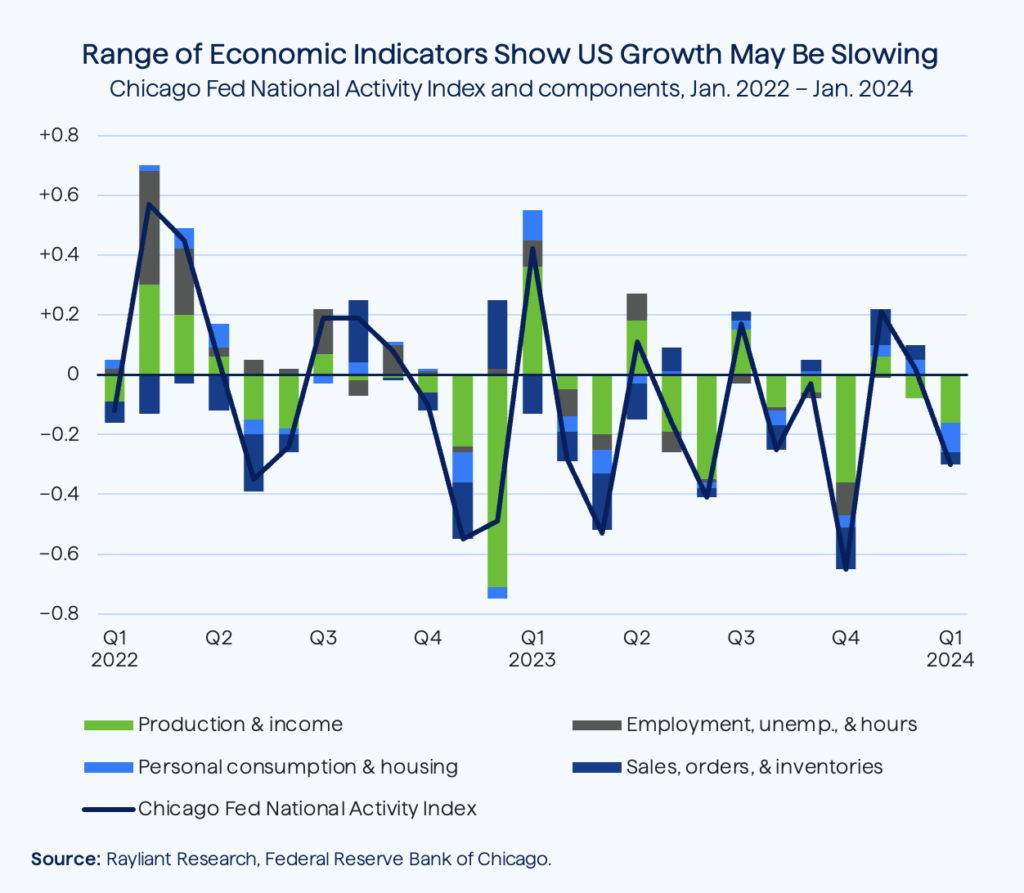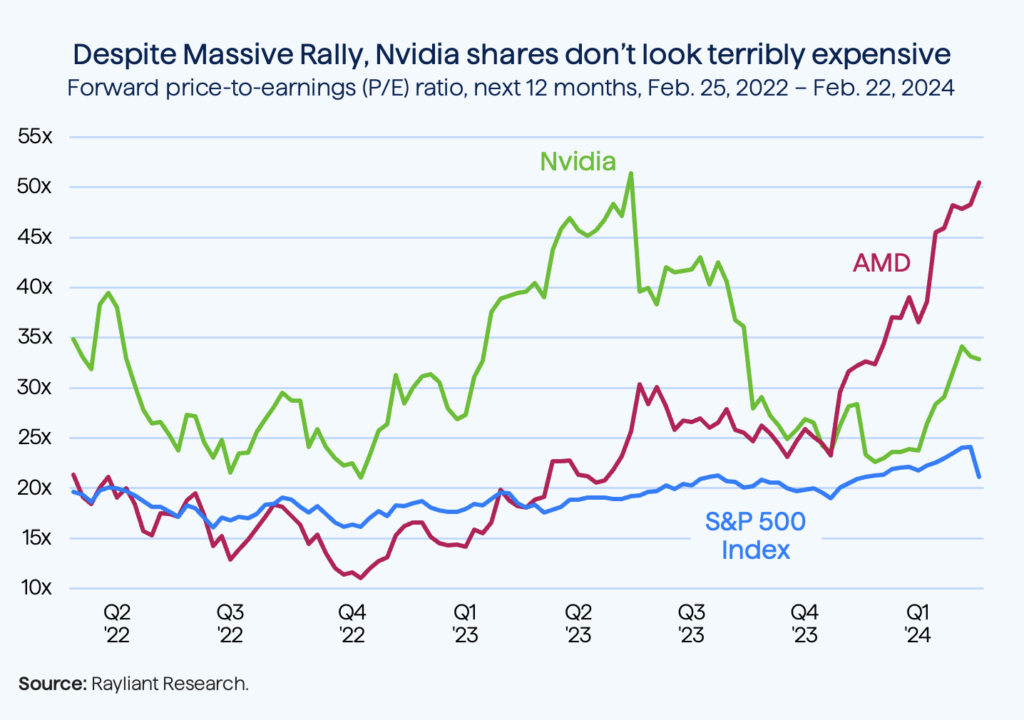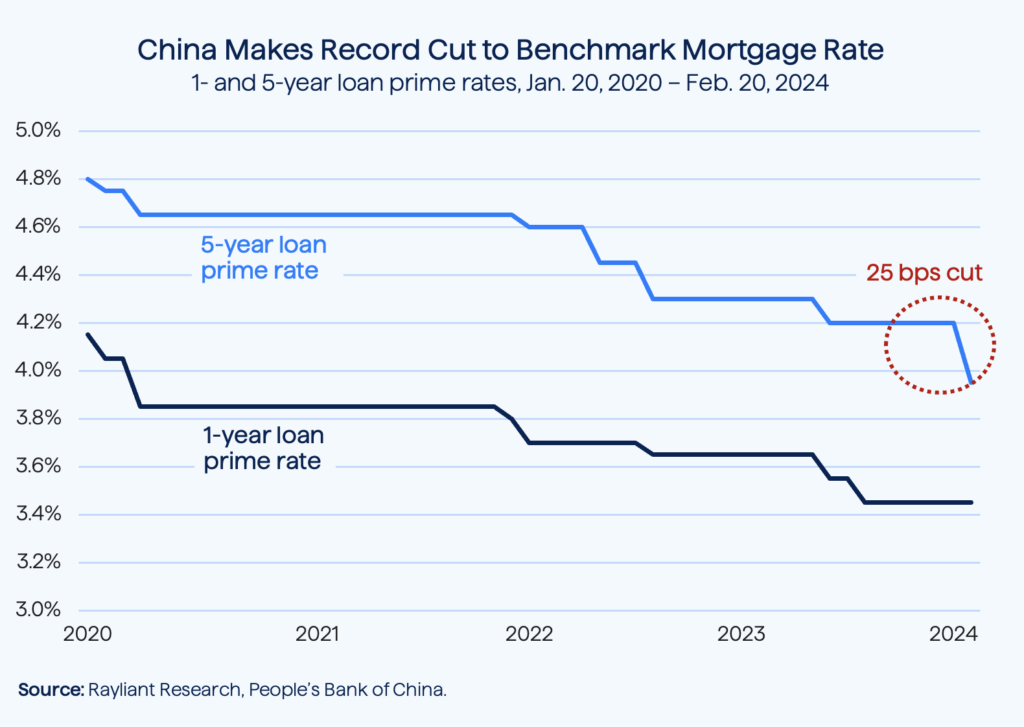
The CIO’s Take:
After weeks of data suggesting the US economy continues running too hot for a quick pivot to easing—including a reacceleration of prices in January CPI—we were pleased to read in recently released minutes from last month’s FOMC meeting that Fed officials are in no hurry to cut rates, afraid of a misstep that might lead to a second wave of inflation and a need to put in further hikes at some point in this cycle. That cautious attitude has started sinking in with traders, who now see a real chance we don’t get any easing before the second half of 2024. Overall, however, we still see risk assets as priced too optimistically, with the S&P 500 trading at around 34x cyclically adjusted earnings: a level it has only seen amidst the dot-com bubble, the runup in stocks as they rebounded from the early 2020 COVID panic, and the month before stocks crashed in 1929. Ironically, one stock that might look like a bubble, US chipmaker Nvidia, actually seems quite reasonably priced as its fundamentals have improved faster than its shares have rallied in the last year. Such a case underscores what we see as a big opportunity for stock pickers, even within a market that feels a little too exuberant. At the level of country allocation, we also see some compelling trades. One of those has been China—though we were admittedly a bit early there. Even so, we’re finally seeing policymakers put more meaningful stimulus in play, with the PBoC last week making a big cut to its 5-year LPR in a bid to boost properties. That’s certainly a step in the right direction, though we want to see more support on the fiscal side to keep up a Chinese New Year rally that’s sent A shares almost 10% higher since early February.
Fed more cautious on cuts
While the January FOMC outcome was no surprise, many investors—ourselves included—were laser-focused on the official statement and post-meeting press conference for any hint as to how the Fed’s thinking was evolving on the issue of when and by how much rates will eventually ease. Last week, we got our hands on another piece of the puzzle: official minutes from the FOMC meeting, released on Wednesday. The good news? That transcript of committee members’ conversation ahead of a decision to hold rates steady in January revealed that “participants judged that the policy rate was likely at its peak for this tightening cycle.” On the other hand, the minutes showed a more cautious stance toward rate cuts than investors seem to have appreciated, with a consensus among officials that more evidence is needed to gain “greater confidence that inflation was moving sustainably toward 2 percent” before it would be prudent to pivot from the current pause to a more accommodative orientation.
Our base case gaining traction
Acknowledging the uncertainty around our forecast, we maintain a base case for easing to begin no earlier than June and to proceed incrementally—perhaps a quarter-point every other meeting—until the three cuts indicated in the FOMC’s December Summary of Economic Projections are achieved. When those dot plots were initially released, our view on the path of policy rates was something of an outlier relative to the forecast of others in the market. The initial reaction by many to December’s dovish Fed messaging was “risk on” with the anticipation of six rate cuts beginning as early as March: sentiment that, in and of itself, led to considerable easing in financial conditions. Over the last two months, however, the consensus has moved in the direction of our original outlook, as hotter-than-expected readings on the economy, including a bounce back in January’s CPI, prompted investors to recalibrate expectations. As of last Friday, CME Group data showed traders pricing a near three-quarters chance the Fed makes it through its May policy meeting without having initiated cuts.
Look out for slowing growth
Wary of a ‘confirmation bias’ that might lead us to unconsciously tune out all but the evidence validating our view of slower and smaller rate cuts, it’s worth highlighting some data on the other side of the ledger. Given last quarter’s staggeringly high US GDP growth, it’s easy to imagine the Fed has plenty of cushion to keep rates high; indeed, that seems to be part of the bank’s logic for letting the data continue to roll in and convince FOMC members inflation will soon return to its 2% target. But we’re also seeing indications that boost to real growth from a positive supply shock last year is waning and nominal growth slowing. So far in January, retail sales and industrial production fell short of expectations and businesses across various sectors are struggling with higher borrowing costs, which dampens their willingness to invest. The Chicago Fed’s National Activity Index, encompassing 85 coincident indicators and measuring overall economic activity, suggests a continuation of below-trend growth (see below).

More challenges loom ahead, including in the corporate debt market, where over $3 trillion in refinancing is set to take place by 2025 amidst stress in the commercial real estate sector due to declining property values. Meanwhile, middle-market companies, the foundation of the US economy and employment, are facing unsustainable double-digit interest rates as economic growth decelerates from last year’s high levels. Considering these data points—and observing that last month’s FOMC minutes show most members emphasizing “the risks of moving too quickly” on cuts—if we turn out to be wrong that the pace of easing is slower than markets expect, it might unfortunately be because the Fed overshot. Either way, the sum of evidence suggests to us caution is still warranted.
Another quarter, another record high
US chipmaker Nvidia (NVDA)—now referred to be some as “The Magnificent One,” replacing the “Seven”…or “Six,” depending on your view as to Tesla’s future—did it again last week, reporting another blowout quarter in its Wednesday Q4 earnings release. The company posted net income for the quarter that was up a mind boggling 769% versus one year ago, on revenues that were 265% greater than those reported in the prior year; both numbers were meaningfully higher than Wall Street consensus estimates. Not surprisingly, much of that increase in the firm’s top and bottom lines was attributable to sales of its chips destined for servers running AI applications, like the H100 GPUs powering software at industry stalwarts like Microsoft and Meta, each of whom shelled out $4.5 billion on Nvidia chips last year. NVDA shares sold off ahead of its earnings, shedding over $106 billion in market cap in trading on Tuesday and Wednesday, before rallying back in Thursday’s trading, which added $277 billion to the company’s value: a record single-day increase. That gain, along with the euphoria its Q4 results and bullish guidance once again inspired, sent the NASDAQ 100 up to a record high of its own, the first time that index gained more than 3% to reach a new peak since the height of the tech bubble in March 2000.
Valuation seems remarkably reasonable
Amazingly, despite those astronomical amounts added to Nvidia’s market cap, its valuation is considerably less eye popping, with the company’s forward P/E sitting at around 35x as of last Friday’s close. In fact, looking at the history of NVDA forward P/E (see below), the stock appears much cheaper today than it did when valuations peaked last May—despite its shares having rallied over 150% since then! That’s because as fast as the company’s stock has been rising, analysts have been even quicker to update forecasts for the firm’s earnings. Nvidia’s guidance helps, with sales growth anticipated to come in at 118.4% in fiscal 2024, followed by 56.5% growth in fiscal 2025. At that rate of expansion, 35x next year’s earnings certainly seems less daunting a multiple. The notion of “growth at a reasonable price” is precisely why Rayliant’s models have actually favored NVDA in recent quarters, despite its meteoric rise.

And while Nvidia’s stellar results sent shares of some competitors higher—chipmaker AMD saw its stock surge by around 12% last Thursday—it’s hard to ignore Nvidia’s 80% share of the AI chip market and 87% share of GPU sales. The fact that AMD trades at over 61x forward earnings highlights the risk we still see of a disconnect between prices and fundamentals as investors chase the AI theme to ever-higher prices. Especially in light of the precarious macro and policy backdrop discussed in the previous section, that makes stock picking all the more important in our view.
PBoC slashes 5-year LPR by most ever
In prior Perspectives, we have discussed our high conviction—based on a review of dispatches from China’s policymaking meetings and signaling from Beijing since late last year—that 2024 will mark a turning point for China’s economy and stock market. Although we expect much of the most impactful policy to come on the fiscal side, the People’s Bank of China (PBoC) last week added some more relief on the monetary front, making a hefty reduction in its Loan Prime Rate (LPR) for tenors of five years or more, slashing it by 25 basis points to 3.95% from 4.2% (see below). That marks the largest cut to date since the country’s transition in 2019 to the LPR framework, and handily surpassed investors’ expectations, which forecasted a more modest cut of 5-10 bps.

The fact that the bank held its one-year LPR steady at 3.45%, as seen above, no doubt reflects a concern about cuts that might further pressure banks’ net interest margins, but more importantly signals strong support for China’s struggling property sector. That’s because the 5-year LPR, in addition to affecting mid- to long-term corporate loan pricing, is a principal benchmark for mortgages. Thus, an aggressive cut to the 5-year LPR should help to boost housing purchases, and also suggests to us the PBoC will be ready to step in with additional monetary support in the event conditions continue to stagnate.
Stocks rally through New Year holiday
And how have those conditions been evolving so far this year? More accommodative signaling from Beijing led stocks to rally going into the week-long Chinese New Year market holiday. Strong data on spending during the festivities prompted optimism coming out of the holiday week, with the CSI 300 Index up nearly 10% through last Friday since hitting lows in early February. Recent data from the PBoC confirm some hopeful signs, with an increase in medium- and long-term household loans, primarily mortgages, suggesting a potential uptick in closely watched property market activities. Short-term household loans also climbed to a 5-year high, marking a possible rebound in consumer spending, as well.
Expect continued monetary support
On the other hand, reports by the National Bureau of Statistic’s report showing a downturn in commercial residential property transactions highlights the need for the PBoC to keep up the stimulus. Such steps include implementing measures to bolster the economy, like the injection of 1 trillion yuan of liquidity into the banking system to encourage lending to agricultural and small enterprises. We do expect the central bank to continue offering support on the monetary side, with adjustments to the Medium-Term Lending Facility (MLF) and 7-day repo rates as real interest rates rise. Eventually, we expect the Fed to help indirectly, as a pivot to easing would definitely provide more leeway to the PBoC by bolstering a weakened yuan. We continue to be encouraged by what we see, but will be on the lookout for indications fiscal policy is working in tandem with monetary moves to promote a China recovery.
You are now leaving Rayliant.com
The following link may contain information concerning investments, products or other information.
PROCEED